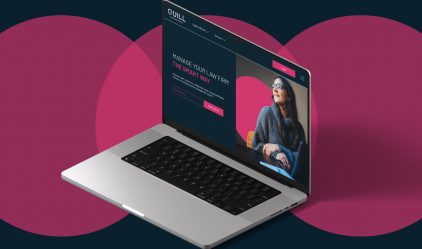
Data access v security tips #4: Digital transformation powered by cloud technology
13/02/23The final instalment in our ‘Data access v security tips’ blog series casts a lens on digitisation by maximising the benefits of cloud computing technology; this being the transformation cloud comprising four parts. Our concluding article finishes with key learnings from the entire series.
The commercial benefits of cloud computing
There are more benefits to cloud computing than simply improved accessibility. When used correctly, it can bring a number of commercial benefits to your law firm.
Technology is altering the way organisations operate. Now, with the power of cloud computing and AI, law firms are realising they can do so much more with their data. While the security of that data is of vital importance, there’s another question which law firms need to consider: “how can we utilise, and get value from, the data we have going forward?”
Don’t forget the objective
There are inefficiencies in every industry. But in law, the key objective is to serve our clients the best we can. Data enables us to identify exactly what our clients expect from us and where we are falling short.
But while the commercial benefits of this might seem obvious, achieving them isn’t so easy. While some 30% of organisations see the potential of AI and machine learning, just 10% manage to make significant financial benefits from it.
The problem isn’t one of technology, but one of conviction. Moving to the cloud can help your firm clearly identify which areas need to be improved, showing you which capabilities you’ll need to add in order to continue delighting your clients.
The transformation cloud
Cloud transformation is the process of migrating work to the cloud, including data, apps and software programs. Your IT infrastructure can also be migrated to the cloud, if that’s in line with your digital transformation objectives.
Now, there are numerous types of clouds for you to choose from online, but perhaps the most important one is what Google calls a “transformation cloud”.
A transformation cloud can accelerate your law firm’s digital transformation through data democratisation, app and infrastructure modernisation, and trusted transactions. In other words, it allows your team to take advantage of all the benefits which come with cloud computing.
But what is it? Thankfully, it’s a lot more simple than it sounds. A transformation cloud is made up of four parts: data cloud, open cloud, trusted cloud and collaboration cloud. Let’s look at each of them now.
Data cloud
The data cloud connects all of your law firm’s data sources into one unified ecosystem, eliminating silos and making it easier to use your data. It gives you a number of capabilities:
- Databases: build interactive global applications that delight users.
- Data analytics: analyse all of your data for real-time insights.
- Business intelligence: visualise all of your data for operational intelligence.
- AI: use the past to predict the future and make better decisions.
Open cloud
The open cloud brings cloud services to different locations, while leaving the operation, governance and evolution of those cloud services to your provider. An open cloud approach enables you to innovate more easily and scale more efficiently — while also reducing technology risk.
Trusted cloud
In simple terms, this is focused on how Google secures its estate in the cloud.
Collaboration cloud
This contains all the utility tools your team needs to work together effectively via the cloud.
A case in point
How Google used data to drive innovation in the law sector
Google was working with a global organisation that was interested in the productivity of its workforce across many different countries.
The firm built a knowledge graph around the connectivity of its lawyers, analysing the way they communicated and connected with each other.
Google Cloud helped surface this data into a dashboard using data-driven techniques. This in turn helped the firm manage and make sure that they had the best people on the right teams at the right time.
The conclusion? Data-driven companies innovate faster.
Four key learnings to finish
At the start of this blog series, we asked the following question: can law firms find the right balance between cloud accessibility and data security? Since then, we’ve explored the data security lifecycle, changing work behaviours and practical security tips to find out exactly what that balance looks like.
So, what have we learned?
1. Getting the balance right IS possible
We’ve seen quite clearly that law firms can get the balance right. There’s no need to be scared of the cloud. On the contrary, it can offer huge benefits to law firms which are willing to treat it with respect, and take advantage of its improved security functions and protocols.
2. No one can afford a breach
The security threat is getting increasingly costly — to the tune of $4.35 million per breach. Law firms which aren’t up to speed with their security already should be looking to change that as soon as possible.
3. Data-driven decision-making is crucial
Basing decisions on data is one of the smartest things a law firm can do. At Quill, we use data to inform many of our business decisions, from what our software looks like, to how it works for our clients. And that’s all because data-driven companies innovate faster.
4. Security never sleeps
The challenge of data security doesn’t end here. It’s a constantly evolving issue that law firms will need to stay on top of if they want to enjoy long-term success. That means training new staff effectively, and ensuring existing employees have their training updated in line with the latest trends and opportunities.
It can take a lot of work, but learning these lessons and putting them into practice is worth the effort. If you can get the balance right, then significant rewards will be there for the taking.
DOWNLOAD E-BOOK
Want to read our earlier blogs in this series? Access ‘Data access v security tips #1: The time is NOW to strike the right balance between access and security‘, ‘Data access v security tips #2: Cyber risks facing your law firm in the new world‘ and ‘Data access v security tips #3: Data security tips straight from experts at Google‘.
More from our blog

15th February
It’s a wrap: January recap and rebrand
Having returned to work rested and recuperated after the Christmas break, we’ve gotten straight into business mode in January, and completed a major phase in our integration into Dye and Durham by rebranding our digital and physical assets.

25th January
Four ways to help your team embrace new technology
Our new top tips cover choosing technology that solves your team's problems, involving your team in the decision, training everyone thoroughly in the new software and phasing in the new system.

18th December
A year in Quill: 2023 under review
In our 2023 review, we thank you for another successful year in business and take you on a trip down Memory Lane.


